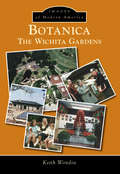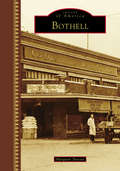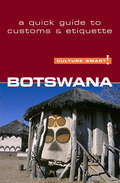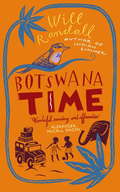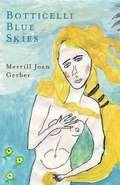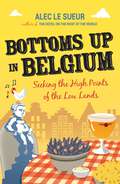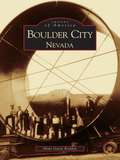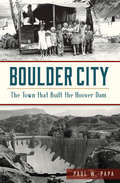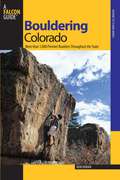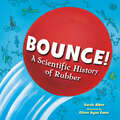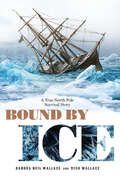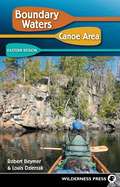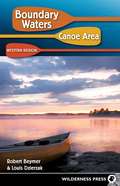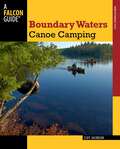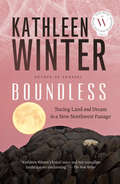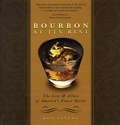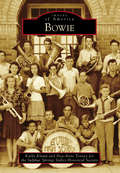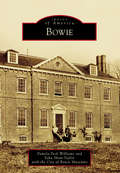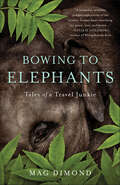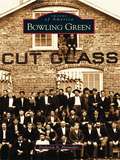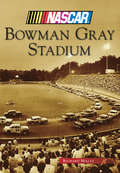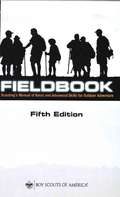- Table View
- List View
Botanica: The Wichita Gardens
by Keith WondraGrowing from 4 gardens in 1987 to 29 in 2015, Botanica, The Wichita Gardens has become a regional attraction. The dream of a botanical garden in Wichita started in the early 1970s with John Firsching, superintendent of landscape and forestry with the Board of Park Commissioners, and in 1987 the gardens opened on the site of Wichita's Sim Park. Images of Modern America: Botanica, The Wichita Gardens tells the story of the people, events, and stories that have shaped Botanica into Wichita's garden. Included are images of Botanica throughout the gardens' 28-year history and the earlier history of Sim Park, many of which have never been published before.
Bothell (Images of America)
by Margaret TurcottThe river community of Bothell began with the arrival of Columbus Greenleaf and George Wilson in 1870. They staked claims along the Sammamish River after navigating from Seattle across Lake Washington and then east along the meandering Sammamish. Bothell was first a logging community, with several mills producing boards and shingles. After the forests were harvested, it became a farming community, connected to other settlements by the river and, after 1887, the railroad. In 1909, Bothell incorporated as a city after a contentious campaign. The vote was 79 to 70 in favor of becoming a city. The population of Bothell in 1910 was 599, but many lived outside the two-thirds square mile original city limits. This book tells the story of Bothell as a central hub, with distinct neighborhoods having their own personalities. Bothell’s population today is almost 43,000, divided between two counties: King and Snohomish.
Botswana - Culture Smart!
by Michael MainCulture Smart! provides essential information on attitudes, beliefs and behavior in different countries, ensuring that you arrive at your destination aware of basic manners, common courtesies, and sensitive issues. These concise guides tell you what to expect, how to behave, and how to establish a rapport with your hosts. This inside knowledge will enable you to steer clear of embarrassing gaffes and mistakes, feel confident in unfamiliar situations, and develop trust, friendships, and successful business relationships.Culture Smart! offers illuminating insights into the culture and society of a particular country. It will help you to turn your visit-whether on business or for pleasure-into a memorable and enriching experience. Contents include* customs, values, and traditions* historical, religious, and political background* life at home* leisure, social, and cultural life* eating and drinking* dos, don'ts, and taboos* business practices* communication, spoken and unspoken"Culture Smart has come to the rescue of hapless travellers." Sunday Times Travel"... the perfect introduction to the weird, wonderful and downright odd quirks and customs of various countries." Global Travel"...full of fascinating-as well as common-sense-tips to help you avoid embarrassing faux pas." Observer"...as useful as they are entertaining." Easyjet Magazine"...offer glimpses into the psyche of a faraway world." New York Times
Botswana Time
by Will RandallWill Randall travels with a purpose, as well as an outrageous sense of fortune. In INDIAN SUMMER he found himself, by chance, having the extraordinary experience of helping slum schoolchildren put on a play to help save their school. In Botswana he was taken up by a headmaster to teach a class of six year olds at The River of Life school. They are football crazy and one of Will's jobs is to take them to play neighbouring (sometimes as much as 100 miles away) schools. Camping en-route or staying in farms and rural villages, often travelling by foot or dug-out punts, thousands of antelope, elephant, buffalo and zebra follow their progress. The sound of lions, leopards and hyenas become the soundtrack of their dreams. Against all the odds they find themselves preparing for the Grand Final of the season - the titanic clash with arch rivals, Victoria Falls Primary school.Both an endearing personal story and a travel book about a little-known but highly successful country, BOTSWANA TIME will win new fans for both Will Randall and the extraordinary country of Botswana.
Botswana Time
by Will RandallWill Randall travels with a purpose, as well as an outrageous sense of fortune. In INDIAN SUMMER he found himself, by chance, having the extraordinary experience of helping slum schoolchildren put on a play to help save their school. In Botswana he was taken up by a headmaster to teach a class of six year olds at The River of Life school. They are football crazy and one of Will's jobs is to take them to play neighbouring (sometimes as much as 100 miles away) schools. Camping en-route or staying in farms and rural villages, often travelling by foot or dug-out punts, thousands of antelope, elephant, buffalo and zebra follow their progress. The sound of lions, leopards and hyenas become the soundtrack of their dreams. Against all the odds they find themselves preparing for the Grand Final of the season - the titanic clash with arch rivals, Victoria Falls Primary school.Both an endearing personal story and a travel book about a little-known but highly successful country, BOTSWANA TIME will win new fans for both Will Randall and the extraordinary country of Botswana.
Botticelli Blue Skies
by Merrill Joan GerberGerber heads to Florence with her husband, a history professor taking a group of students. She goes in nervous, not knowing any Italian, but gradually starts to learn her way around Florence and other cities in Italy.
Bottoms up in Belgium: Seeking the High Points of the Low Lands
by Alec Le SueurAlec had never been to Belgium, so it came as some surprise when he found himself at the altar of a small church in Flanders, reciting wedding vows in Flemish. It was the start of a long relationship with this unassuming and much maligned little country. He vowed to put worldwide opinion to the test: just how boring can Belgium be?
Bottoms up in Belgium: Seeking the High Points of the Low Lands
by Alec Le SueurAlec had never been to Belgium, so it came as some surprise when he found himself at the altar of a small church in Flanders, reciting wedding vows in Flemish. It was the start of a long relationship with this unassuming and much maligned little country. He vowed to put worldwide opinion to the test: just how boring can Belgium be?
Boulder City, Nevada
by Mimi Garat RoddenThe Boulder Canyon Project Act, authorized by Congress in 1928, designated funds for the construction of the Hoover Dam. This monumental undertaking affected the interests of seven states and is considered by many to be the most significant American public works project of the 20th century. A project of this scope required thousands of workers, and to meet their needs, the Bureau of Reclamation planned the town of Boulder City, Nevada. Today, the planning of Boulder City is recognized as a significant influence on modern city planning. To a country shaken to its roots by the tumultuous effects of the Great Depression, the Hoover Dam project provided two essentials that were in short supply: work and housing. With the planned community of Boulder City, there was yet another benefit--an oasis in the desert, a city with character and charm. From the hot, barren, cactus-covered land rose green lawns and gardens, workers and their families created a new sense of community, culled from their hard work and the massive dam that was rising before their eyes.
Boulder City: The Town that Built the Hoover Dam (Brief History)
by Paul W. PapaIn the depths of the Great Depression, the United States undertook a task so monumental it demanded nearly five thousand people to complete. The Hoover Dam stands as a modern marvel, a testament to America’s ingenuity. However, few know the story of the town that built the dam. To house the workers, Secretary of Interior Ray L. Wilbur envisioned a model of city planning, giving birth to Boulder City. Wilbur intended for the city to be temporary, to disappear once the dam was complete, but it didn’t work out that way. Local author Paul W. Papa offers a unique look at a town that may have been forged by a dam but took on a life of its own.
Boulder: 1859-1919
by Boulder History Museum Mona LambrechtBorn out of the 1859 Pikes Peak gold rush, Boulder sits along the Front Range where the Rocky Mountains meet the plains. Discoveries of gold, silver, telluride, and coal nearby put the little supply town on the map, and early miners, farmers, and businessmen prospered there. The railroad's arrival in 1873 brought more newcomers who cultivated a diverse community full of new businesses, social organizations, and schools, and the town flourished despite the social problems and economic fluctuations that were typical of early mining towns. By the 1890s, education, health, and tourism had become significant to Boulder's economic development, a pattern that continues to this day. Great change came about during the early 1900s in the form of a citywide alcohol prohibition, the influenza epidemic, and the closure of the "Switzerland Trail" railroad in 1919, but Boulder weathered these difficult times even as it witnessed the end of the great railroading era.
Bouldering Colorado: More Than 1,000 Premier Boulders Throughout The State (Bouldering Series)
by Bob HoranBOULDERING COLORADO: More than 1,000 Premier Boulders throughout the StateBob Horan (Falcon)The all-new climbers&’ guide with nearly twice the listings of any otherColorado is one of the world&’s premier bouldering destinations, and Boulder resident Bob Horan has been climbing them all for 35 years. Horan has established hundreds of new routes and boulder problems, pushing standards such as the first free ascent of the Rainbow Wall, which is Eldorado Canyon&’s first 5.13, as well as Beware the Future (5.14) in the Flatirons. This original book contains nearly 4,000 individual routes covering the entire state, with some listings found nowhere else. Geared to all skill levels, the book is enhanced by roughly 900 detailed maps and full-color color photos accompanying Horan&’s comments. Bob Horan has been climbing since he was a teenager, and has written extensively about it in several books and magazines. He and his family live in Boulder.
Bounce!: A Scientific History of Rubber
by Sarah AlbeeEver wondered what makes rubber bounce? Or why it's stretchy? And WHY is rubber so . . . rubbery?! Learn the facinating science and history behind this ubiquitous material!With sidebars, graphics, fun facts, and more, the history of rubber reveals plenty of fascinating secrets and surprises. Elementary school readers will discover that early balls didn't bounce; that people in the rainforest made waterproof gear from rubber thousands of years before Europeans got into the act; and that sneakers, bicycles, and cars created demand for more and more rubber!Back matter includes a time line and a bit about the complicated implications of harvesting rubber.
Bound by Ice: A True North Pole Survival Story
by Rich Wallace Sandra Neil WallaceIn the years following the Civil War, “Arctic fever” gripped the American public, fueled by myths of a fertile, tropical sea at the top of the world. Several explorers attempted to find a route to the North Pole, but none succeeded. Bound by Ice follows the journey of George Washington De Long and the crew of the USSJeannette, who departed San Francisco in the summer of 1879 hoping to find a route to the North Pole. However, in mid-September the ship became locked in ice north of Siberia and drifted for nearly two years before it was crushed by ice and sank. De Long and his men escaped the ship and began a treacherous journey in extreme polar conditions in an attempt to reach civilization. Many—including De Long—did not survive. <P><P> A riveting true-life adventure, Bound by Ice includes excerpts from De Long’s extensive journals, which were recovered with his body; newspapers from the time; and photos and sketches by the men on the expedition. The title also includes an epilogue, author’s note, bibliography, source notes, and index.
Boundary Waters Canoe Area: Eastern Region
by Louis Dzierzak Robert BeymerWith thousands of lakes and streams, over 1200 miles of canoe routes, 160 miles of portage trails, and 2000 campsites, the Boundary Waters Canoe Area Wilderness is a true paddler's paradise. Extending nearly 150 miles in northern Minnesota along the Canadian border, the wilderness area encompasses more than 1 million acres. This Eastern Region edition of the classic two-volume guide has been fully updated by area journalist Louis Dzierzak, with full coverage of 50-plus entry points and routes. Trip descriptions include day-by-day paddling distances, portage tips, and difficulty ratings, and identify the appropriate water-resistant, topographic maps W.A. Fisher maps for each trip. Together, these books deliver everything a visitor needs for the experience of a lifetime.
Boundary Waters Canoe Area: Western Region
by Louis Dzierzak Robert BeymerWith thousands of lakes and streams, over 1200 miles of canoe routes, 160 miles of portage trails, and 2000 campsites, the Boundary Waters Canoe Area Wilderness is a true paddler's paradise. Extending nearly 150 miles in northern Minnesota along the Canadian border, the wilderness area encompasses more than 1 million acres. This Western Region edition of the classic two-volume guide has been fully updated by area journalist Louis Dzierzak, with full coverage of 50-plus entry points and routes. Trip descriptions include day-by-day paddling distances, portage tips, and difficulty ratings, and identify the appropriate water-resistant, topographic maps W.A. Fisher maps for each trip. Together, these books deliver everything a visitor needs for the experience of a lifetime.
Boundary Waters Canoe Camping (Paddling Series)
by Cliff JacobsonA heart-warming, thoroughly modern, marvelously illustrated guide, BoundaryWaters Canoe Camping is aimed at paddlers in the Boundary Waters Canoe Area in Minnesota and covers places to go, planning a canoe trip, navigating, selecting a canoe and rigging it out, selecting equipment, camping and cookery, traveling with children, and dealing with hazards--all brought to you by one of America's most renowned canoeing experts, Cliff Jacobson. This completely updated and revised edition includes more than 100 stunning full color photos, new product ideas, and revised appendices. GPS navigation information has been added, and a new chapter on solo canoeing details how to paddle, portage and pack these personal-sized watercraft. Also new is a section with sage advice from some of the top Boundary Waters paddlers.
Boundless: Tracing Land and Dream in a New Northwest Passage
by Kathleen WinterThe long-awaited follow up to Annabel and Kathleen Winter’s first work of narrative nonfiction.In 2010, bestselling author Kathleen Winter took a journey across the storied Northwest Passage, among marine scientists, historians, archaeologists, anthropologists, and curious passengers. From Greenland to Baffin Island and all along the passage, Winter bears witness to the new math of the melting North — where polar bears mate with grizzlies, creating a new hybrid species; where the earth is on the cusp of yielding so much buried treasure that five nations stand poised to claim sovereignty of the land; and where the local Inuit population struggles to navigate the tension between taking part in the new global economy and defending their traditional way of life.Throughout the journey she also learns from fellow passengers Aaju Peter and Bernadette Dean, who teach her about Inuit society, past and present. She bonds with Nathan Rogers, son of the late Canadian icon Stan Rogers, who died in a plane crash when Nathan was nearly four years old. Nathan’s quest is to take the route his father never travelled, except in his beloved song “The Northwest Passage,” which he performs both as anthem and lament at sea. And she guides us through her own personal odyssey, emigrating from England to Canada as a child and discovering both what was lost and what was gained as a result of that journey.In breathtaking prose charged with vivid descriptions of the land and its people, Kathleen Winter’s Boundless is a haunting and powerful story, and a homage to the ever-evolving and magnetic power of the North.
Bourbon at its Best
by Ron GivensWhether they drink it straight, on the rocks, or in classic cocktails, Americans love their bourbon. Bourbon at Its Best is the most comprehensive guide to this drink available, with detailed descriptions of these elixirs, from the tried and true ways in which they are made to the amazing range of flavors they deliver. Bourbon at Its Best reveals the flavorful history of this red-white-and-blue spirit, from its rural origins as "corn likker" to its rough- and- tumble days as moonshine to its downright genteel status as a premium liquor. Readers will find out what makes bourbon different from other whiskeys of the world and how to truly savor all of its better qualities. They'll experience the magic of bourbon-making first-hand, traveling to classic distilleries in America's heartland. Perfect for both newcomers and connoisseurs, Bourbon at Its Best is an entertaining, informative tour of this intoxicating world.
Bowie
by Peta-Anne Tenney Kathy Klump Sulphur Springs Valley Historical SocietyFounded in 1880 along the Southern Pacific Railroad line, Bowie is located in northern Cochise County. It was originally named Teviston after Capt. James H. Tevis, operator of the Butterfield Overland Stage Station. Later, the town was named after nearby Fort Bowie, which was the scene of many battles with the Chiricahua Apaches. In 1886, the Apaches, including Geronimo and Cochise's son Naiche, were loaded on trains in Bowie and sent to Florida as prisoners of war. The Indian Wars in America were over. Bowie became a major shipping point for the military and the mines. A beautiful train station with a first-class hotel and dining room served the thousands of passengers traveling through. Great soil, pleasant climate, and artesian wells attracted homesteaders who grew every kind of fruit and vegetable imaginable. Ranchers in the nearby mountains shipped cattle by hundreds of carloads at a time. After US Highway 86 was completed, Bowie became a favorite stopping point for travelers. Pecans, pistachios, and wine from local vineyards attract visitors today.
Bowie (Images of America)
by City of Bowie Museums Pamela Peck Williams Yoku Shaw-TaylorNestled in the heart of Prince George�s County, the city of Bowie has grown from a Colonial farming area to become one of Maryland�s largest cities. Its rich history is intertwined with those of the railroad, early tobacco culture, the rise of suburbia, and Thoroughbred racing. Belair Mansion and Stable bred some of the 20th century�s most brilliant racers, including two Triple Crown winners raced under the Belair colors. The Belair Mansion and Stable remain today as two of Thoroughbred racing�s most historic places. Built on the railroads, the city�s birthplace was Huntington City. At the heart of Huntington was Bowie Station, named for Maryland governor Oden Bowie, an important figure in the presence of the railroad in the area. Today, the city of Bowie is a growing, vibrant, and diverse city, incorporating almost 400 years of history in its story. Bowie is a true American hometown where the present celebrates the past every day.
Bowing to Elephants: Tales of a Travel Junkie
by Mag DimondIn Bowing to Elephants, a woman seeking love and authenticity comes to understand herself as a citizen of the world through decades of wandering the globe. During her travels she sees herself more clearly as she gazes into the feathery eyes of a 14,000-pound African elephant and looks for answers to old questions in Vietnam and the tragically ravaged landscape of Cambodia. Bowing to Elephants is a travel memoir with a twist―the story of an unloved rich girl from San Francisco who becomes a travel junkie, searching for herself in the world to avoid the tragic fate of her narcissistic, alcoholic mother. Haunted by images of childhood loneliness and the need to learn about her world, Dimond journeys to far-flung places―into the perfumed chaos of India, the nostalgic, damp streets of Paris, the gray, watery world of Venice in the winter, the reverent and silent mountains of Bhutan, and the gold temples of Burma. In the end, she accepts the death of the mother she never really had―and finds peace and her authentic self in the refuge of Buddhist practice.
Bowling Green (Images of America)
by Frederick N. HonnefferThe Great Black Swamp may have slowed the settlement of northwest Ohio, but it couldn't stop a little town south of Toledo called Bowling Green. It blossomed into an agricultural gold mine with natural gas and oil booms that prospered the modest Wood County seat late in the Nineteenth Century. Now as the home of internationally known Bowling Green State University, the National Championship Tractor Pulling Competition, and the Black Swamp Arts Festival, this formerly uninhabitable swamp continues to attract its fair share of attention. In this pictorial history you will learn how Bowling Green beat the odds to become the city everybody wants to revisit.
Bowman Gray Stadium
by Richard MillerWith the sounds of engines roaring since 1949, Bowman Gray Stadium is NASCAR's oldest weekly race track. Named in honor of the former R.J. Reynolds CEO Bowman Gray, this quarter-mile track has been the host to many exciting racing moments. Bowman Gray Stadium showcases the rich history of many of the major racing dynasties, including members of the Petty, Earnhardt, and Allison families, and celebrates the races and traditions that have kept spectators and race fans coming week after week for over 50 years. Today, Bowman Gray Stadium's weekly racing tradition continues as part of the NASCAR Whelen All-American Series.
Boy Scouts Of America Fieldbook
by Boy Scouts Of America StaffBased on experiences of millions of Scouts and leaders, this book holds essential information for every outdoor enthusiast. A comprehensive reference, this handbook includes sections on trek, preparation and adventures, appreciating our environment, and more.
